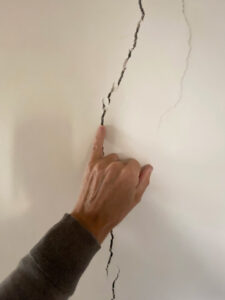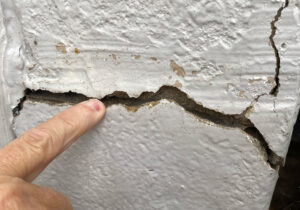 Reason for contacting us
Reason for contacting us
A long-term owner/occupier contacted us following recommendations by a surveyor. The owner was concerned about significant cracking, in excess of 10 mm wide, to the rear of the property which was letting in damp and cold air. They were concerned that a wider subsidence problem might exist.
Pole Structural Engineers Reports were contacted by the owner who were seeking a reputable, independent, and highly experienced structural engineering firm specialising in the East London area.
Pole service offer
In response to the client’s requirements our qualified Chartered Structural Engineer recommended a General Movement Report.
There are two distinct types of structural engineers reports:
1) A localised, very specific and limited Structural Engineers Defect Report or a Specific Structural Inspection Report (SSI).
2) A broader Structural Engineers General Movement Report, or General Structural Inspection Report (GSI), which focuses on matters of cracking and movement only.
Our report
The property was a conventional mid-terrace family dwelling house on two floors with the normal two-storey rear projection. A number of very large trees, including a 20 metre tall oak tree, were approximately fifteen metres from the rear of the property, and there were other similar height trees in neighbouring gardens.
The local geology was known to be London Clay. A communal drain also passed close to the rear of the property. The condition of the property was fairly dated.
A crack also existed to full height within a party wall and we advised the neighbouring owner at the same time.
Findings
 We found a continuous crack at damp proof course level where the whole of the rear elevation had subsided by about 10‑12 mm.
We found a continuous crack at damp proof course level where the whole of the rear elevation had subsided by about 10‑12 mm.
In addition, we found a substantial crack in the party wall where the forward and rear halves of the property meet on the landing at the top of the staircase. This is a very common location for a crack due to the way Victorian properties were built in two halves with little or no mechanical bond between the two.
The party wall crack was approximately 5 mm wide in the decorated parts, but 20 mm wide within the roof space where it had, of course, never been repaired or decorated.
We concluded that there was an ongoing subsidence problem probably associated with tree roots from the large oak tree. We recommended that the tree be reduced in size but, given that the tree was a fair distance from the property, an exploratory hole or trial pit should be excavated to check whether or not fine hair roots had passed beneath the foundations.
We also advised that they should consider introducing a tree root barrier to reduce future risks. A tree root barrier is a continuous trench with a curtain or concrete barricade that intercepts the tree roots before they reach the house. In addition, we recommended that the drains be tested.
We recommended that the owner consult their insurance company to determine if it is financially viable to pursue a formal subsidence claim. They should consider the costs involved and whether it is necessary to have the claim registered, taking into account potential consequences for future property sales.
The crack repairs would be fairly simple, comprising of normal cementitious grout that should be installed by a specialist contractor.
In terms of future recurrence of the same type of damage, this would depend on the findings of the exploratory trial hole and the presence of any tree roots beneath the property since some ninety per cent of subsidence cases only occur when there are large trees nearby.




